Human Flower Project
Tuesday, April 22, 2008
Geobotany: Rocking the Garden World
Nature first put flowers on stone pedestals, but gardeners of the Picturesque school followed, with painterly landscapes of their own. Well done, say the EarthScholars: But, please, give rocks equal time!

Trees, Fort Greene Park, 2004
by Kerry O’Neill
By James H. Wandersee and Renee M. Clary
EarthScholars™ Research Group
Unwittingly, people view landscapes through the lenses of their prior knowledge and experiences. They compare the new landscapes they visit with ones they already know. Given that more than half of the world’s inhabitants now live in big cities, more and more people lack an extensive personal knowledge of nature. Nor have most people, urban or otherwise, traveled to explore a variety of conserved natural ecosystems —experiences they could use in making comparisons and aesthetic decisions about the new landscapes they encounter.
There are many theories about how humans perceive landscapes. The Australian environmental scholar Andrew Lothian poses the question: Is landscape quality inherent in the landscape or in the eye of the beholder? He opts to defend the latter.
R.P. Taylor, writing in the journal Leonardo, recalls that, “In art school I was told that Monet’s water lilies calm the observer, while van Gogh’s sunflowers electrify. To what extent, however, do paintings [of landscapes] really affect the observer’s physical condition? The foundations of this question date back to 1890, when the connection between psychological states and physiological states was first considered.”
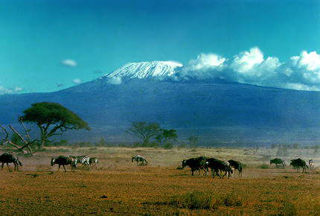 A famous African Savannah,
A famous African Savannah,
the Maasai Mara
Photo: Masai Mara
Judith Heerwagen, in her article on the Psychosocial Value of Space, notes: “Drawing on habitat selection theory, ecologist Gordon Orians argues that humans are psychologically adapted to and prefer landscape features that characterized the African savannah, the presumed site of human evolution….If the ‘savannah hypothesis’ is true, we would expect to find that humans intrinsically like and find pleasurable environments that contain key features of the savannah that were most likely to have aided our ancestors’ survival and well-being.”
Features of the savannah landscape include a fairly unobstructed “big sky” view, a high diversity of flowering plants, scattered clusters of trees with high canopies, swaths of open grassland, occasional rocky outcrops, multiple visual corridors, and topographic changes to enhance predator surveillance and long-distance escape movements.
Do humans really prefer these, or other, particular landscapes? History shows us that colonialists and emigrants sometimes attempted to transform their new landscapes of residence into replicas of those they had known. Presuming the superiority of “The Old Country,” they tried to mimic what they considered “civilized spaces”—importing plants, seeds, and even rocks from their landscapes of origin.
Just as people’s first maps showed their tribes or cities at the center of the world, it is common for us all to judge new landscapes by the rather xenophobic criteria of familiarity and congruence with our original cultural values and preferences.
In 18th century England, complex debates developed about the essence of beauty in the landscape—with followers of the ‘Sublime’ school inspired by wild, natural landscapes (simultaneously fascinating and startling), while those of the ‘Picturesque’ school wanted ‘painterly’ landscape views (human-designed to be blurred, disjointed, and soft composites of color and contour).
Followers of the latter were willing to have flowering plants moved from their traditional positions in borders or against walls, provided they were regrouped to form non-linear, painterly compositions (“painting with plants”). The eye of the landscape artist (painter), with its aesthetic understanding of nature and training in the principles of composition, was thought to be the best guide to good planting design.
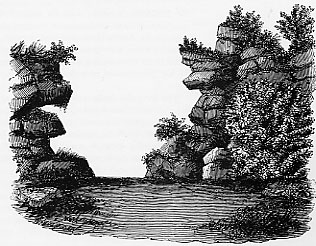 Plant Hunter Joseph Dalton Hooker’s Rhododendrons of the Sikkim-Himalaya (1849-51)
Plant Hunter Joseph Dalton Hooker’s Rhododendrons of the Sikkim-Himalaya (1849-51)
Image: Garden Visit
The Picturesque school had a pronounced effect on landscape design. It both justified using foreign plants in British gardens and provided a system of compositional principles to harmonize the intermingling of exotic and native plants and natural objects. Instead of the plantings being natural of themselves, landscape designers were to use art to imitate rugged natural scenes in aesthetic ways.
In the second half of the nineteenth century the Picturesque Style was used, for example, in the making of woodland gardens. Landowners on the western shores of the British Isles installed rhododendron woods, arranged in “painterly compositions.” As can be seen from Hooker’s print (above), the art that inspired Paxton’s landscape (below), making effective use of jagged irregular lines of plant and rocks, represents the furthest possible conceptual distance from an artificial geometrical regularity. In contrast, fractal geometric patterns predominate—for both plants and rocks.
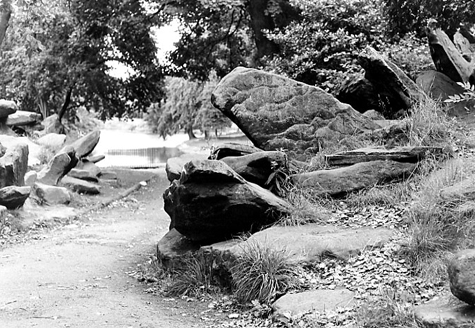
Landscape at England’s Birkenhead Park, Designed by Joseph Paxton
Photo: Garden Visit
Like Charles Darwin, Joseph Dalton Hooker saw the need to integrate botany and geology to understand nature. When he was only 5 years old, Joseph regularly attended his father’s botanical lectures at the University of Glasgow, and displayed a genuine interest in the subject. Because his parents thought Glasgow High School’s curriculum was too limited, he and his brother were withdrawn from formal schooling to be home-schooled. In those days, botany was still regarded as merely a branch of medicine, so like every other young Glaswegian botanist in his day, Hooker studied for his medical degree at the University of Glasgow. This education later proved to be quite expedient because, in 1839, Sir James Clark Ross, famous discoverer of the magnetic north pole as well as his father’s good friend, offered young Joseph the position of Assistant Surgeon on Clark’s expedition to the Antarctic, aboard the discovery ships Erebus and Terror.
This four-and-half-year voyage allowed Hooker to botanize in many lands and also to notice the natural relationships between botany and geology. At the Kerguelen Islands, where Captain Cook had managed to collect just 20 new species of plants, Joseph identified and collected over 150 different species, including flowering plants, 3 ferns, 35 mosses, and the rest lichens and seaweeds. This was no easy task, as the cold, harsh weather and rough terrain made collecting very challenging. Hooker wrote: “Many of my best little lichens were gathered by hammering out the tufts, or sitting on them till they thawed.” Joseph later became assistant director of the Royal Botanic Gardens at Kew, near London.
One result of the English affinity for Picturesque landscape design was an enthusiasm for rock gardens. A European rock garden, also known as an alpine garden, features extensive use of rocks or stones, along with plants native to rocky alpine or tundra environments.

Alpine flowers on tundra along Trail Ridge road
Rocky Mountain National Park, Colorado
Photo: Q.T. Luong
In 1803, Europe’s first alpine garden was constructed at Belvedere Castle in Vienna. The best rock gardens were designed and built to look like natural outcrops of bedrock (e.g., limestone, sandstone). Stones were aligned to suggest a bedding plane and plants were often used to conceal the joints between the stones. This type of garden was especially popular in Victorian England as well.
The first rock garden of appreciable size to be constructed at an American botanic garden opened at Brooklyn Botanic Garden in 1917. Today, some of the best alpine rock gardens may be viewed at the Royal Botanic Garden in Edinburgh, Scotland; Le Jardin Botanique Alpin du Lautaret, Grenoble, France; Cambridge University Botanic Garden, Cambridge, England; Royal Horticultural Society Garden, Wisley, England; New York Botanical Garden, Bronx, NY; Devonian Botanic Garden, Devon, Alberta, Canada; Göteborg Botanical Garden, Gothenburg, Sweden; Betty Ford Alpine Gardens, Vail, Colorado; Jardin Botanique de Montrèal, Montreal, Quebec, Canada; and the Tromso Arctic-Alpine Botanic Garden, Tromso, Norway.
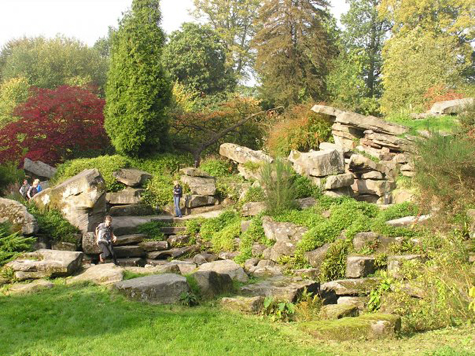
A Picturesque rock garden at Chatsworth Manor, England
Photo: Michelle Anstett
Although the use of rocks as decorative and symbolic elements in gardens can be traced back to very early Chinese and Japanese gardens, rock gardens dedicated to growing alpine plants have a shorter history. During the age of the great plant explorers (basically, the 1800s) there was great interest in the exotic discoveries being brought back to England, and people wanted to grow these amazing new treasures successfully. Although others had previously written about growing alpine plants, it was actually Reginald Farrer who, with the 1919 publication of his two-volume book The English Rock Garden, rocked the gardening world for the first time. There was great interest in Farrer’s method and approach to creating large-scale, naturalistic settings for growing alpine plants.
(For more about the man credited with starting the rock gardening craze, read Nicola Shulman’s biography of Farrer).
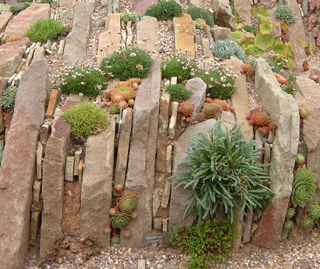 Alpine Crevice Garden
Alpine Crevice Garden
Alpine Garden Society Center
Pershore, Worcestershire, England
Photo: Stone Garden
Because our own research group focuses on the integration of botanical and geological knowledge, we strongly recommend that public rock gardens interpret both the plants and the rocks that are present. The public trails we have designed always include geobotanical interpretation. As visitors tread the rock garden’s paths examining the alpine plants, we think it is helpful for the visitors to understand the geologic history of any garden site, to know what kind of rocks they are seeing and their influences on plant growth.
We appreciate, for example, University of Florence’s Botanical Garden exhibit that interprets the geobotany of the alpine plants of Italy’s Dolomite region via a simulated outcrop of limestone derived from the Dolomite Mountains themselves. Similarly, we think the rock garden at the Botanic Garden of Montreal is exemplary from a geobotanical perspective. It’s not only a rock garden, but also a mineralogical garden, with rocks and minerals drawn from all over Canada.
Finally, if you live in the US, be sure to experience the Denver Botanic Garden’s remote 1.5-mile Walter Pesman Trail through the alpine tundra on Mount Goliath, a mountain peak section of the Mount Evans area within the Arapaho National Forest (17 miles from Idaho Springs). Volunteer guides will interpret not only the plants but also the rocks that you see in this “nature-made” alpine rock garden, but only during the summertime days when the alpine flowers are in bloom, June 26th to August 7th. (Reservations are required: phone 720-865-3539). The Denver Botanic Garden within the city also has a fine rock garden, with thousands of different rockery plants collected by Panayoti Kelaidis—the godfather of American rock gardening.
We conclude with a passage from author Donna E. Schaper: “Building a quiet [sanctuary] of stones and plants, slowly and meditatively over time, is [a rock garden’s] true meaning. Process over product, journey over destination, forever a work in progress—rock is the best metaphor we have of everlastingness.”
Art & Media • Culture & Society • Gardening & Landscape • Travel • Permalink




